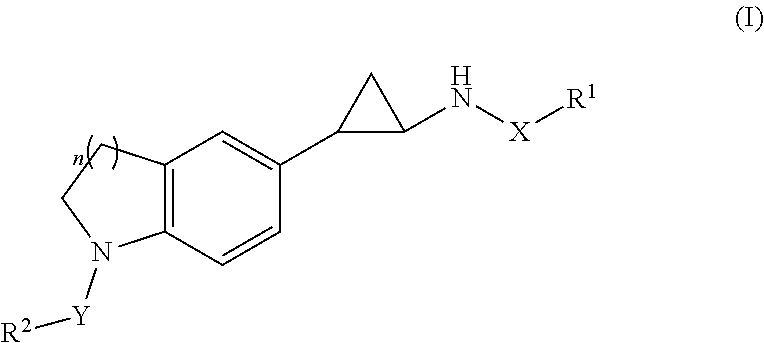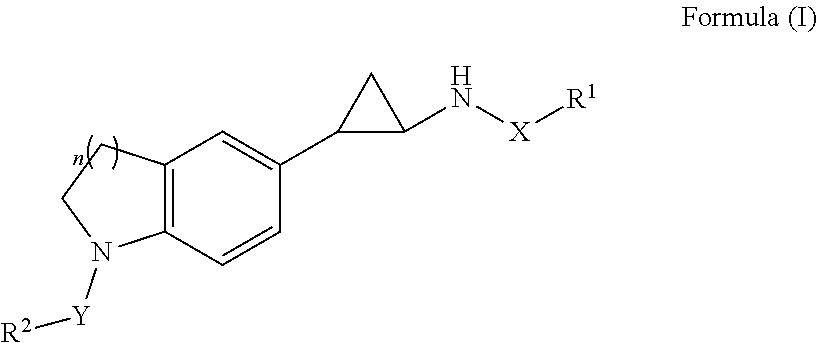Trans-indoline cyclopropylamine chemical compound, and method for preparation, pharmaceutical composition, and use thereof
a technology of cyclopropylamine and cyclopropylamine, which is applied in the field of fluorine substituted cyclopropylamine compounds, can solve the problems of inappropriate inhibition of downstream abnormal gene targets for leukemia-causing genes
- Summary
- Abstract
- Description
- Claims
- Application Information
AI Technical Summary
Benefits of technology
Problems solved by technology
Method used
Image
Examples
example 1
Trans-2-(1-(phenylsulfonyl)indolin-5-yl)cyclopropylamine (A1)
[0069]
1.1 Synthesis of 1-(phenylsulfonyl)indoline
[0070]
[0071]In an ice-bath, triethylamine (163 mL, 1.17 mol) was added to a solution of indoline (100 g, 839.18 mmol) in dichloromethane (1 L) under stirring, and then benzene sulfonyl chloride (128 mL, 1.01 mol) was added slowly dropwise. After one hour, it was slowly warmed to room temperature and stirred overnight. After verified by TLC that the reaction was completed, deionized water (200 mL) was slowly added under an ice bath. The organic layer was washed successively with deionized water (1.0 L), saturated aqueous sodium bicarbonate (1.0 L) and saturated brine (1.0 L) for one time. The obtained organic layer was dried over anhydrous sodium sulfate and concentrated under reduced pressure to provide a crude product. Finally, the crude product was purified through recrystallization with ethanol under heating to afford an intermediate (201 g, 92% yield). 1H NMR (400 MHz, D...
example 2
trans-N-phenyl-2-(1-(phenylsulfonyl)indolin-5-yl)cyclopropylamine (A2)
[0081]
[0082]A1 (200 mg, 0.57 mmol) was dissolved in dichloromethane (20 mL), and 1 M aqueous sodium hydroxide solution (20 mL) was added for neutralization. The resulting liquid was extracted three times with dichloromethane (20 mL), and the combined organic layer was washed once with saturated brine. The resulting organic solution was dried over anhydrous sodium sulfate, and concentrated under reduced pressure to provide a pale yellow liquid. The liquid was re-dissolved into 4 mL of dimethyl sulfoxide, and iodobenzene (175 mg, 0.86 mmol), cuprous iodide (11 mg, 0.057 mmol) and L-valine (13 mg, 0.114 mmol) were added successively. The resulting reaction solution was heated and stirred in a 90° C. oil bath overnight under argon atmosphere. After verified by TLC that the reaction was completed, ethyl acetate was added for dilution, and washed three times with deionized water. The obtained organic layer was washed wi...
example 3
trans-N-benzyl-2-(1-(phenylsulfonyl)indolin-5-yl)cyclopropylamine (A3)
[0083]
[0084]A1 (200 mg, 0.57 mmol) was dissolved in dichloromethane (20 mL), and 1 M aqueous sodium hydroxide solution (20 mL) was added for neutralization. The resulting liquid was extracted three times with dichloromethane (20 mL), and the combined organic layer was washed once with saturated brine. The resulting organic solution was dried over anhydrous sodium sulfate, and concentrated under reduced pressure to provide a pale yellow liquid. The liquid was re-dissolved in 10 mL of methanol, and benzaldehyde (41 mg, 0.38 mmol) and glacial acetic acid (44 μL, 0.76 mmol) were added successively. The resulting reaction solution was stirred under reflux for 10 minutes under argon protection. After the reaction solution was cooled to room temperature, sodium cyanoborohydride (45 mg, 0.76 mmol) was slowly added. After stirred to react for 24 hrs, saturated sodium hydrogencarbonate solution was added slowly to quench th...
PUM
 Login to View More
Login to View More Abstract
Description
Claims
Application Information
 Login to View More
Login to View More - R&D
- Intellectual Property
- Life Sciences
- Materials
- Tech Scout
- Unparalleled Data Quality
- Higher Quality Content
- 60% Fewer Hallucinations
Browse by: Latest US Patents, China's latest patents, Technical Efficacy Thesaurus, Application Domain, Technology Topic, Popular Technical Reports.
© 2025 PatSnap. All rights reserved.Legal|Privacy policy|Modern Slavery Act Transparency Statement|Sitemap|About US| Contact US: help@patsnap.com



